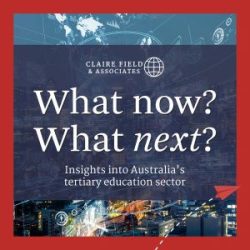In its draft of Australia’s International Education and Skills Strategic Framework, the government wants to do more to encourage international students to enrol in courses to meet Australia’s skills shortages, claiming that this will avoid graduates becoming ‘permanently temporary’. This two-part piece draws on my response to the consultation question, including repeating mistakes of previous governments, inconsistent messaging, as well as a paper by the ANU Migration Hub this week calling ‘permanently temporary’ migration a myth.
The consultation question in the draft Australia’s International Education and Skills Strategic Framework asks how government should determine which courses are best aligned to Australia’s skills needs. It argues that if students take courses aligning with Australia’s skills needs it will help meet Australia’s future workforce requirements and help avoid graduates becoming ‘permanently temporary’.
‘Permanently temporary’
The Review of the Migration System Final Report handed to government in March 2023 raised concerns about what it called an “emergence of ‘permanently temporary’ migrants in Australia”, those who have been in Australia for five or more years without a path to permanent residency causing ethical and economic concerns for Australia and to migrants. The Review found that former international students are among the largest cohort of ‘permanently temporary’ migrants.
A myth
In the ANU Migration Hub paper released this week, Understanding Australian Migration 2024 (TKN 190624), author Emeritus Professor Peter McDonald calls ‘permanently temporary’ migration a myth. He argues that few have been in this category for more than ten years, and that the recent rise in temporary entrants who have been resident for 5-10 years “are the result of the policies of successive governments that have allowed temporary residents to jump from one temporary visa to another” (ie visa-hopping). This includes, for example the 192,000 holders of a student or graduate visa that ‘hopped’ to a 408 visa in 2022-23.
Graduate employment
That brings us back to students enrolling in courses that align with Australia’s skills needs to meet workforce requirements.
The Migration Review notes that “International students should be good candidates to move from study into Australia’s permanent skilled visa stream. However, they do not perform as well as might be expected in our labour market”.
Various studies have shown, however, that international graduates struggle to find employment in Australia in their field of expertise (Deakin University, 2017), meaning that even if students enrol in courses that align with skills needs, these students may still not be employed in the skills shortage area once they graduate from their course.
In October 2023, the Grattan Institute called for the government to “stop offering false hope to international graduates”, finding that graduates are being left in “visa limbo” with only half of Temporary Graduate visa-holders securing full-time employment, most working in low-skilled jobs and half earning less than $53,300 a year.
Graduates are often underemployed or employed in low-skilled jobs such as hospitality and transport. One of the biggest reasons cited in these studies is a reluctance of employers to consider employing international graduates, with Grattan citing that some of the reluctance comes from the uncertainty about visa pathways once their Temporary Graduate visa expires.
Before encouraging students to enrol in courses that meet Australia’s skills needs, the government would do well to first solve the issue of what happens once they graduate with the following recommendations:
- Migration Review: “first, improve students’ chances in our labour market”
- Grattan Institute: “Australia should do more to help international graduates thrive here”
- ANU Migration Hub: “Those on a graduate visa could be assisted through governmental processes to find employment commensurate with their skill level, with the involvement of all levels of government including local”
See part one here.

















